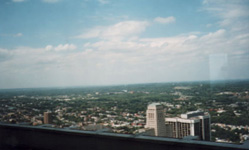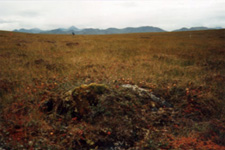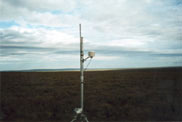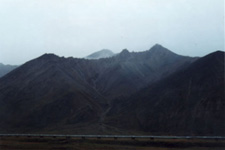Students in Arctic Research (STAR) | Javier Lopez
Spring Hill, Florida
Project: Soil Active
Layer/Landscape Interactions on the North Slope
of Alaska
Principal Investigator: Dr. Fritz Nelson,
University of Delaware, Newark, Delaware
TEA Teacher: Donald Rogers, Spokane, Washington
Follow-up Visit
Javier and Don returned to Dr. Nelson's laboratory in Delaware to analyze the data they collected and enter it into the global climate change model that Dr. Nelson's team is working on. To see their results, go to Don's page on the TEA Web Site.
 Biography
Biography
Having never before seen snow, Javier's trip to the Arctic in August to perform research was truly an extreme experience. A tremendous amount of energy is required for Dr. Nelson's project to walk across the tundra collecting data along established transects to study the interaction between climate change, atmospheric gases, and the tundra. While hiking across the tundra, Javier also collected samples for an independent project that he will complete at the University of South Florida (USF) in Tampa, Florida. Javier has been studying a glycoprotein involved in cellular reproduction with researchers in an oncology laboratory at USF. Previously, he studied cell proliferation in frog eggs, but now Javier will look for this glycoprotein in one species of Alaskan lichen at two life stages&emdash;one proliferative and one dormant. As a student at River Ridge High School, Javier has won numerous awards in state math competitions. This year he won 1st place at his school's science fair for his project on the rate of enzyme activity, and he was invited to attend the State Science Fair. Javier is a member of the National Honor Society and Mu Alpha Theta, a national math club. In addition to his interest in math and science, Javier is an outstanding classical pianist, a member of the tennis team and an avid rollerblader. After graduating from high school in spring of 1999, Javier looks forward to attending college out of state, and to other opportunities to experience different parts of the country.
Memoirs of the Summer, 1998
By Javier Lopez
I live in Florida, the home of flat lands, oranges,
and lack of culture. The Spanish, Seminoles, and
early plantation owners might argue about the latter
conclusion, but they are unaware of the commercial
sprawl that has engulfed the nature. If we wish to go
hiking, the nearest fluctuation in elevation is
Georgia, well over 100 miles away. No, there are only
two places to go hiking here: the swamps and the
cattle farms. You can stand in one place and see only
for about a mile, at best. The trees cover all, and
there is no way to get over them. I have only been on
a mountain once in my life, during a trip to Puerto
Rico when I was nine; tropical regions like Florida
(technically it is the subtropics) are where I have
lived all of my life. If snow ever fell, it would
fall when I was sleeping drifting down in my dreams,
but never landing, never precipitating for me. I have
never experienced snow, but I soon discovered that
people who live with it see it as common or trite,
even as an annoyance. They are not amused by the
beauty or aesthetic pleasure, or if they once were,
that flame has long since been extinguished.

Don, the math teacher from Washington State, was late when he arrived at Albany on the first day of our trip. Anna Klene (clen-ee, is the pronunciation - she's quite adament about that) greeted us both with a warm smile and a busy schedule. Anna is a graduate student at SUNY Albany (State University of New York at Albany), but transferred with Dr. Nelson to The University of Delaware. They had already moved their personal items, but had most of the equipment still at SUNY Albany.
Dr. Nelson, greeted us the next morning and led us to a conference room, where he had obviously taken some time to prepare an extensive introduction to our fieldwork in the Arctic. He is a brilliant man, using erudite verbiage while carrying out his presentation. You might think that he was presenting for the National Science Foundation themselves that morning, but it was only us. After the 'training', we embarked to the mysterious world of Alaska. While flying over the Rocky Mountains, I thought: Wow, those mountains are pretty high. But they kept on getting higher. I wondered if this mountain range would ever end; right after one wrinkle in the ground disappeared, another soon took its place, but this one would be higher and grander than the last. We flew over mountains that had lakes of melted snow trapped in their interior; we flew over snow covered mountains that pierced the upper layers of clouds sending the fluffy amorphous masses flying higher into the sky; we flew over dormant volcanoes and meandering rivers, spreading silt into the waiting seas; then, finally, we flew over Alaska. Below us was a layer of thick clouds, making the ground and low lying mountains completely impervious to my fascinated gaze. My first view of Alaska was cursed by the unpredictable weather. It seemed that my first impressions of this realm would have to wait.
The next day at the ARCUS office, we met Renee Crain. She showed us around town; we saw the Large Animal Research Station, the University of Alaska, Fairbanks, the Cold Regions Research and Engineering Laboratory's permafrost tunnel. Then, before we could soak up any more culture, science, or nature from Fairbanks, we were off to Prudhoe Bay. In the meantime, a wonderful friend of Dr. Nelson's had joined us. This intriguing character was Sam Outcalt, Dr. Nelson's professor from when Nelson was a graduate student. The chemistry between the two of them was incredible: they would play off of each other's wits in these conversations about anything, including a bidet! What caught my attention, however, was the experience and advice that Sam just exuded. He gave advice for some projects and speculated about geography theory -- and when there was nothing to comment about, he reminisced about his past. He told stories of Russian KGB agents stalking him in Japan; he told us about a plane crash and bears and the military. He told us about how things used to be... back when he was a greenhorn researcher out in the tundra.
 After arriving at Prudhoe Bay, we then
drove down the Dalton Highway to the Toolik Field
Station. We passed these markers on the road that
told us the miles we were traveling. It seemed like
only twenty minutes from the 20 mile marker to the 80
mile marker; in the coastal plains, there was a huge
expanse of untouched tundra. No trees. You could see
for miles, but I knew later that those were not
miles. Those were hundreds of miles, thousands of
miles. The land fifty miles away looked identical,
having the same smells, mosses, rivulets, rocks, and
animals. The land here was a huge tessellation,
standard in form, but varied as the structures of
polygons: within those polygons were more cracked
polygons. It was the detail within the repetition
that I really took an interest in. I enjoyed how this
part of the tundra was almost the same as the next.
When I looked out of the truck window into the field,
I saw more there than I had my entire life. I saw the
individual tussocks, rising and falling constantly in
the hills.
After arriving at Prudhoe Bay, we then
drove down the Dalton Highway to the Toolik Field
Station. We passed these markers on the road that
told us the miles we were traveling. It seemed like
only twenty minutes from the 20 mile marker to the 80
mile marker; in the coastal plains, there was a huge
expanse of untouched tundra. No trees. You could see
for miles, but I knew later that those were not
miles. Those were hundreds of miles, thousands of
miles. The land fifty miles away looked identical,
having the same smells, mosses, rivulets, rocks, and
animals. The land here was a huge tessellation,
standard in form, but varied as the structures of
polygons: within those polygons were more cracked
polygons. It was the detail within the repetition
that I really took an interest in. I enjoyed how this
part of the tundra was almost the same as the next.
When I looked out of the truck window into the field,
I saw more there than I had my entire life. I saw the
individual tussocks, rising and falling constantly in
the hills. They merged with the other
vegetation growing between the tussocks and they
formed this living sea that stretched out for miles
before me. This was the tundra, superb and grand in
scale, yet quiet and placid with its caribou and musk
oxen slowly eating vegetation. I could never see the
food running out for them; they had this entire area
to graze: the world was their buffet.
Then we arrived at Toolik. The time, which had stopped on our trip through the tundra, had shown us that even out here, it is the maker of the day and the night (or the few hours of dusk that people called night). I slept that night like a child, dreaming of losing myself in the land, waking up in the middle of the tundra, no roads, no cars, just caribou in the distance and the rising sun, partially covered by clouds, illuminating the endless waves of land. I would walk for hours, seeing caribou waltzing off down hills and toward small streams for water. I dreamed of the snow again, falling down around me. It seemed in reach, palpable to senses, unlike before. My jacket held pockets of ethereal white dust. Snow collected on my gloves, but I did not take them off. I woke up cold and tired, still from walking.
When we did the actual field work, which consisted of measuring the active-layer depth over this huge kilometer grid, I experienced a fear that I had not expected the night before. Dr. Nelson had mentioned that bears frequent the area under research; specifically, one had used a positioning marker as a scratching post just hours after it was set up. That day, I finished my field work a little early.
 The actual work involved was pushing
this metal rod that is partitioned like a meter
stick, down into the ground until ice is met (that
ice being the permafrost). Every summer, the top of
the permafrost melts, allowing the growth of organics
such as lichen and mosses. This level also contains
peat, which is readily decomposed by microorganisms
to produce carbon dioxide, a 'greenhouse gas'. Dr.
Nelson, his graduate students, and other researchers
have been working on a continuous study of this
active-layer depth to determine if it's depth is
changing at a regular rate. Luckily, there are
computer models that do great jobs in predicting
these trends (given the correct parameters and data).
These programs also do a good job mapping the active
layer for trends over the years.
The actual work involved was pushing
this metal rod that is partitioned like a meter
stick, down into the ground until ice is met (that
ice being the permafrost). Every summer, the top of
the permafrost melts, allowing the growth of organics
such as lichen and mosses. This level also contains
peat, which is readily decomposed by microorganisms
to produce carbon dioxide, a 'greenhouse gas'. Dr.
Nelson, his graduate students, and other researchers
have been working on a continuous study of this
active-layer depth to determine if it's depth is
changing at a regular rate. Luckily, there are
computer models that do great jobs in predicting
these trends (given the correct parameters and data).
These programs also do a good job mapping the active
layer for trends over the years.
 The next evening at Toolik, we went
farther down the Dalton Highway. It was only Anna,
Don, and I who took the journey. She said that it
would only take an hour to get to the Brooks Range;
this was the same range that, on a clear day, you
could see all the way from Prudhoe Bay. On the entire
trip to Toolik, I could see them, clouded and fogged
in the distance. After an hour, we had reached the
ancient glacial passage. I, for the first time in my
life, saw the snow covered mountains and the verdant
valleys filled with the same tundra that I had seen
the day before. The only reaction I could have was
amazement; the whole scene was breathtaking,
gorgeous. The mountains were so smooth from afar,
that it seemed like hot magma had poured on their
slopes and hardened there without erosion every
touching it. When we reached Atigun Pass, we could
just reach out and grab the mountains. The rocks were
red and the slopes were no longer smooth as they had
been before. The truck climbed the road that was
tucked into the side of the mountain, and from that
elevation, we could see the valley, complete with
blue-green waterfalls, below us. As we reached the
top of the pass, it began to sleet, a phenomenon that
was new to me. We then descended the other side of
the pass and turned around. When we reached the top
of the pass, it began to snow. We stopped the car and
Anna and I got out.
The next evening at Toolik, we went
farther down the Dalton Highway. It was only Anna,
Don, and I who took the journey. She said that it
would only take an hour to get to the Brooks Range;
this was the same range that, on a clear day, you
could see all the way from Prudhoe Bay. On the entire
trip to Toolik, I could see them, clouded and fogged
in the distance. After an hour, we had reached the
ancient glacial passage. I, for the first time in my
life, saw the snow covered mountains and the verdant
valleys filled with the same tundra that I had seen
the day before. The only reaction I could have was
amazement; the whole scene was breathtaking,
gorgeous. The mountains were so smooth from afar,
that it seemed like hot magma had poured on their
slopes and hardened there without erosion every
touching it. When we reached Atigun Pass, we could
just reach out and grab the mountains. The rocks were
red and the slopes were no longer smooth as they had
been before. The truck climbed the road that was
tucked into the side of the mountain, and from that
elevation, we could see the valley, complete with
blue-green waterfalls, below us. As we reached the
top of the pass, it began to sleet, a phenomenon that
was new to me. We then descended the other side of
the pass and turned around. When we reached the top
of the pass, it began to snow. We stopped the car and
Anna and I got out.
When my warm fingers reached out to touch the snow, it disappeared quickly in my hand, leaving only the clear water that it had originated from. I have read about snow and I have seen snow in movies, but the experience of snow was something that I just enjoyed. It is hard to describe my emotions, but when you see something that is simple in form it is like a connection to your past. I felt that I could melt out there with the snow and live in that state of bliss forever.
The next day, we woke up to the welcoming snow covered ground. We did the probing of the active-layer out in that snow covered ground. We trudged through the thin layers of snow, and we worked. Is this heaven, I thought to myself. No, this is what I want to do: I want to wake up to the snow covered ground and do research cuddled between that soft snow below your feet and the white clouded sky above your head. It was this gift that ARCUS and TEA have given to me, a gift that I shall not soon forget.
Anna, Don, Dr. Nelson, Sam, and
everyone else has left a mark on my character. If
only I could strive to be as committed as Dr. Nelson,
or as honest and caring as Anna, or as brilliant as
Don, or as wise as Sam, then, I very well think, I
will suffer from multiple personalities, but I will
be happy.
When I arrived home, I was very disappointed. The nature that I had woken up to was covered with regularly planted trees, not the random assortment that nature gives rise to. The nature I woke up to was filled with cars and traffic, worries and problems. I still have memories, however, of the incredible lakes and caribou trotting just in the distance. I still dream that I'm in that land, wandering... wondering.

